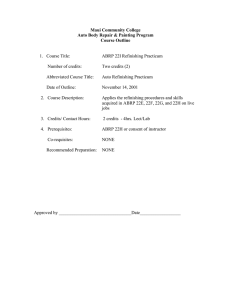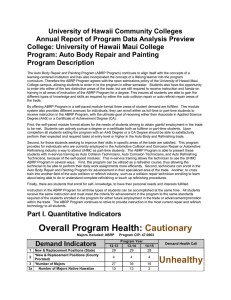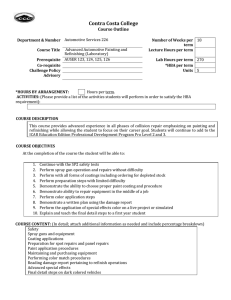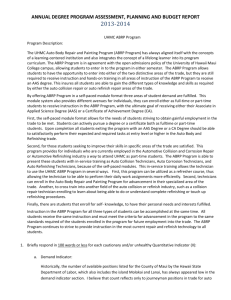Auto Body Repair
advertisement
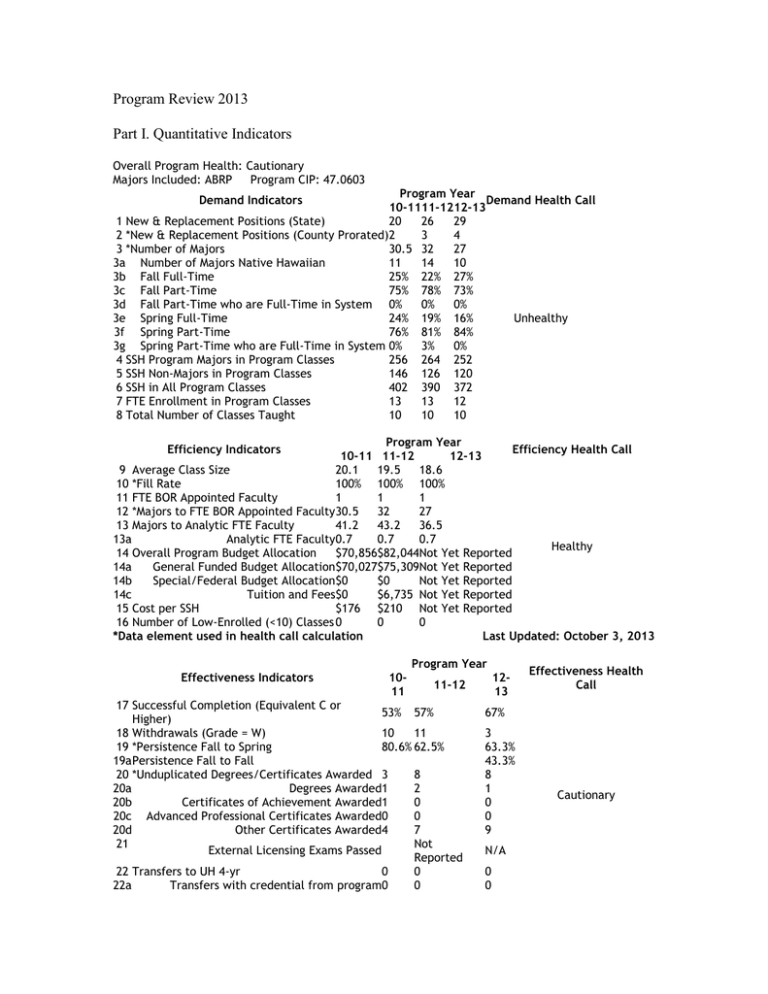
Program Review 2013 Part I. Quantitative Indicators Overall Program Health: Cautionary Majors Included: ABRP Program CIP: 47.0603 Program Year Demand Health Call 10-1111-1212-13 1 New & Replacement Positions (State) 20 26 29 2 *New & Replacement Positions (County Prorated)2 3 4 3 *Number of Majors 30.5 32 27 3a Number of Majors Native Hawaiian 11 14 10 3b Fall Full-Time 25% 22% 27% 3c Fall Part-Time 75% 78% 73% 3d Fall Part-Time who are Full-Time in System 0% 0% 0% 3e Spring Full-Time 24% 19% 16% Unhealthy 3f Spring Part-Time 76% 81% 84% 3g Spring Part-Time who are Full-Time in System 0% 3% 0% 4 SSH Program Majors in Program Classes 256 264 252 5 SSH Non-Majors in Program Classes 146 126 120 6 SSH in All Program Classes 402 390 372 7 FTE Enrollment in Program Classes 13 13 12 8 Total Number of Classes Taught 10 10 10 Demand Indicators Program Year Efficiency Health Call 10-11 11-12 12-13 9 Average Class Size 20.1 19.5 18.6 10 *Fill Rate 100% 100% 100% 11 FTE BOR Appointed Faculty 1 1 1 12 *Majors to FTE BOR Appointed Faculty 30.5 32 27 13 Majors to Analytic FTE Faculty 41.2 43.2 36.5 13a Analytic FTE Faculty0.7 0.7 0.7 Healthy 14 Overall Program Budget Allocation $70,856$82,044Not Yet Reported 14a General Funded Budget Allocation$70,027$75,309Not Yet Reported 14b Special/Federal Budget Allocation$0 $0 Not Yet Reported 14c Tuition and Fees$0 $6,735 Not Yet Reported 15 Cost per SSH $176 $210 Not Yet Reported 16 Number of Low-Enrolled (<10) Classes 0 0 0 *Data element used in health call calculation Last Updated: October 3, 2013 Efficiency Indicators Program Year Effectiveness Indicators 1011 1213 11-12 17 Successful Completion (Equivalent C or 53% 57% Higher) 18 Withdrawals (Grade = W) 10 11 19 *Persistence Fall to Spring 80.6% 62.5% 19a Persistence Fall to Fall 20 *Unduplicated Degrees/Certificates Awarded 3 8 20a Degrees Awarded1 2 20b Certificates of Achievement Awarded1 0 20c Advanced Professional Certificates Awarded0 0 20d Other Certificates Awarded4 7 21 Not External Licensing Exams Passed Reported 22 Transfers to UH 4-yr 0 0 22a Transfers with credential from program0 0 Effectiveness Health Call 67% 3 63.3% 43.3% 8 1 0 0 9 N/A 0 0 Cautionary 22b Transfers without credential from program0 0 0 Distance Education: Program Year Completely On-line Classes 10-1111-1212-13 23Number of Distance Education Classes Taught 0 0 0 24Enrollments Distance Education Classes N/A N/A N/A 25Fill Rate N/A N/A N/A 26Successful Completion (Equivalent C or Higher) N/A N/A N/A 27Withdrawals (Grade = W) N/A N/A N/A 28Persistence (Fall to Spring Not Limited to Distance Education) N/A N/A N/A Perkins IV Core Indicators Goal Actual Met 2011-2012 291P1 Technical Skills Attainment 90.00 57.14 Not Met 302P1 Completion 50.00 57.14 Met 313P1 Student Retention or Transfer74.25 81.25 Met 324P1 Student Placement 60.00 66.67 Met 335P1 Nontraditional Participation 17.00 11.76 Not Met 345P2 Nontraditional Completion 15.25 25.00 Met Program Year 10-1111-12 12-13 35Number of Degrees and Certificates 1 36Number of Degrees and Certificates Native Hawaiian 0 37Number of Degrees and Certificates STEM Not STEM 38Number of Pell Recipients 19 39Number of Transfers to UH 4-yr 0 *Data element used in health call calculation Last Updated: October 3, 2013 Performance Funding Part II Quantitative indicators has historically shown that the number of available positions listed for the County of Maui, which also includes the islands of Molokai and Lanai, as always low in the demand indicator section. Even though the auto collision and refinishing trade here on the island of Maui is always inquiring every semester with the UHMC ABRP Program about prospective students to hire, skilled or semi-skilled, as technicians. For each semester over the past five years, an average of at least three auto body repair and refinish shops or related businesses have contacted the ABRP Program for students for part-time employment, with a preference for advanced students nearing graduation from the ABRP program for future full-time employment as either collision/corrosion technicians or refinish technicians or in a related trade. So the open positions statistics count for Maui County may not be an accurate account of available jobs at any given time. The UHMC ABRP Program has always been able to fulfill the requests of the auto collision and refinish industry, as well as other related businesses in Maui County. The ABRP Program has maintained its student enrollment numbers, even though the amount of program majors enrolled in the APRP Program is low and traditionally has not a been strong point for this program. This is because instruction on auto collision, corrosion and refinishing is presented in a self-paced format; many students are enroll as part-time students for several reasons and it is these students that choose to not declare themselves as majors in the ABRP Program as to not wanting to commit themselves. A few examples are: first, there are traditional and non-traditional students that are just feeling out the trade to see if they would like to pursue this as a career, so they would enroll in only one or two the beginning modules. Next, the self-paced module format fills the needs of students striving to obtain skills for entry-level employment in the trade and they have no desire in receiving their Certificates of Completion, Certificates of Achievement and/or an Associate in Applied Science Degree. Third, there are students that are currently employed in the trade or a related trade, enrolling in a class or two only to improve their knowledge and level of proficiency in the trade. And finally there are students enrolling for self- knowledge seeking only to have their immediate needs fulfilled and are referred to as the “hobby shoppers". These students have stated that they would prefer not declare themselves as majors in the program, as they believed it would require a commitment from them to eventually enroll fulltime and also be compelled to complete all the required courses for a degree seeking student just to remain in the program. Most full-time students enrolled in the program usually declare themselves as majors in the program as they are working towards receiving their certificates and degrees from the program. Persistence of program majors from semester to semester is usually at 50% or near it. The persistence of returning students both majors and non-majors has increased to it highest percentage, with 54% of students returning from the previous semester. As a part of the ABRP Program’s action plan, implementation of IICAR curriculum to the program has been ongoing. Increased student participation in classroom and laboratory exercises and activities may have been a cause for this improvement for the past three years. Or the hiring of a lecturer as noted earlier could also be a part of this increase. The UHMC ABRP program had successfully met its goals in four areas: 2P1 Completion, 3P1 Student Retention or Transfer, 4P1 Student Placement, and 5P2 Nontraditional Completion. But fell short of goals in the other two areas: 1P1 Technical Skills Attainment, 5P1 Nontraditional Participation. Since the UHMC ABRP program has dropped again in the 1P1 Technical Skills Attainment indicator, it is a cause for concern. It is possible that the implementation of the IICAR based curriculum package has had an effect because of the higher level of information presented to the students that have completed the basic courses and were enrolled in the advance courses. The 1P1 Technical Skills Attainment indicator should improve as the new incoming students are receiving more of the IICAR based curriculum included with in their basic course offerings. As for the Perkins 5P1 core indicator, there have been several nontraditional students enrolled in the UHMC ABRP Program, but they did not continue on to complete the program. These students have either encountered personal, financial, and academic situations that they could not cope with and dropped out unofficially and officially. They are now back and my goal is to insure they are accounted for in 5P2 Nontraditional Completion. Part III Student retention has always been an important issue for the ABRP Program. With the increased enrollments for the past several years, a lecturer has been hired for the two evening class sessions to help with the over load of students. The lecturer assists with the students in the laboratory, allowing the instructor to devote more time to evaluating and grading the extra students assignments and also being able to spend a little more time to the classroom portion of the program. At this time it became obvious the student retention has been increasing as more students have been returning the following semesters. I believe that by having two instructors, one in the laboratory and one in the classroom is what produced an increase in the persistence rate for returning students. This was in part because both instructors are able to provide more one-on-one support needed, instead of one instructor being stretched thin with up to 20 beginning and advanced students, with each student doing a different task or assignment in either the laboratory or classroom. As stated in previous reviews, having one instructor teaching and evaluating the students while they are actively participating in laboratory exercises and another instructor helping the students with their classroom activities, with both instructors respectively grading each student practical and written assignments. An alternative would be to have one instructor for the first year students and another for the second year students. I believe either system will work, but the latter being a better choice as each instructor then can spend more time with his specific group of students. Particularly, for the first year students that require much more guidance and encouragement to remain in and to complete the program. This could possibly be a movement to place the program in the right direction in dealing with the issue of student retention and increasing program majors, along with increasing graduation rates as well. Another program enhancement that has been mentioned by the ABRP Advisory Committee members is to incorporate more computer skills related assignments into the curriculum. Employing computer based instruction for auto body repair and refinishing and allowing students to be able to take their test and quizzes on line, using campus resources such as Laulima. Part IV The existing application equipment will need to be updated to be able to properly apply water-borne materials. The anticipated enforcement of EPA mandates for automotive refinishing Volatile Organic Compound (VOC) output limits, the refinishing industry is heading towards water based refinishing products. The equipment employed by the ABRP Program currently will suffice only for short-term use with the application of water-borne materials will require updating and replacement within the next few years. Also, explore the feasibility of having an additional faculty member or a full-time lecturer. As stated in previous sections, one instructor to provide instruction and supervision in the laboratory, while the another instructor is in the classroom working with students, or one instructor for the first year students and one for the second year students. Either option is workable to enhance student retention, increase program majors, and improve completion/graduation rates. Comprehensive Review Information Please provide some information about the last comprehensive review for this program. The last Comprehensive Program Review was completed in the 2012-2013 Academic year. At this point in time, there minimal activities are happening as pertaining to any major programmatic changes for the ABRP Program. Description Please provide a brief description of your program and program mission. As the University of Hawaii Maui College continues to emphasize the thought of being a learning-centered institution, the Auto Body Repair and Painting Program (ABRP Program) continues to align itself with the concepts of a learning-centered institution and has also incorporated the concept of a lifelong learner into the program curriculum. The ABRP Program also agrees to the open admissions policy of the University of Hawaii Maui College campus, allowing students to enter in to the program in either semester. Students also have the opportunity to enter into either of the two distinctive areas of the trade, but are still required to receive instruction and hands-on training in all areas of instruction of the ABRP Program for a degree. This insures all students are able to gain the different types of knowledge and skills as required by either the auto collision repair or auto refinish repair areas of the trade. Also by providing the ABRP Program in a self-paced module format three areas of student demand are fulfilled. First, the self-paced module format allows for the needs of students striving to obtain gainful employment in the trade to be met. Next, for students looking to improve their skills in specific areas of the trade are satisfied, and finally students enrolled for self- knowledge also have their needs fulfilled. Instruction in the ABRP Program for all three types of students can be accomplished at the same time. All students receive the same instruction and must meet the criteria of the students enrolled in the program for employment into the trade. The ABRP Program continues to strive to provide instruction in the most current repair and refinish technology to all students. The module system also provides different avenues for individuals, they can enroll either as full-time or part-time students to receive instruction in the ABRP Program, with the ultimate goal of receiving either their Associate in Applied Science Degree (AAS) or a Certificate of Achievement Degree (CA). The first avenue, students can actively pursue a degree or a certificate as fulltime students. Upon completion all students exiting the program with an AAS Degree or a CA Degree should be able to satisfactorily perform their expected and required tasks at entry level or higher in the Auto Body and Refinishing trade. Next, this program also provides for individuals who are currently employed in the Automotive Collision and Corrosion Repair or Automotive Refinishing industry a way to attend UHMC as part-time students. The ABRP Program is able to present these students with in-service training as Auto Collision Technicians, Auto Corrosion Technicians, and Auto Refinishing Technicians, because of the self-paced modules. This in-service training allows the technician to use the UHMC ABRP Program in several ways. First, this program can be utilized as a refresher course, thus allowing the technician to be able to perform their daily work assignments more efficiently. Second, technicians can enroll in the Auto Body Repair and Painting Program for advancement in their specialized area of the trade. Another, to cross train into another field of the auto collision or refinish industry, such as a collision repair technician enrolling to learn about being able to do or understand complete refinishing or touch up refinishing procedures. Program Learning Outcomes. 1.Explain and describe both personal and public health and safety issues as it pertains to the products used in the auto collision repair and auto refinishing industry. Describe in general the effect of these products have on themselves, co-workers and the environment. Demonstrate proper personal and public safety precautions to be utilized when using these products. Will be able to identify hazardous products and describe the proper methods of disposal for different types of hazardous waste. 2. Describe and demonstrate proper and safe usage as pertaining to the hand and power tools and equipment needed to complete the required tasks for auto body sheet metal repair for the return both exterior and interior sheet metal of a vehicle to a like new condition. 3. Employ required math and reading skills to be able to complete vehicle repairs as described from a work order and also written specifications when using vehicle service information or a vehicle dimensioning manual, obtained either as a hard copy or on line. Be able to communicate both written and verbally with fellow employees and other shop personnel. 4. Demonstrate the proper MIG and resistance spot welding skills required to achieve a weld that is equal to factory specifications for a given type of repair, in a safe manner. Be able to identify and correct MIG and resistance spot welds that are not compliant with factory recommendations for acceptable repairs. 5. Display the appropriate refinishing skills required to achieve a vehicle topcoat (finish) that is equal to factory refinishing specifications. Describe the health and safety issues surrounding the use and disposal of refinishing and related materials. Be able to identify and correct paint imperfections in the topcoat to meet factory recommendations for an acceptable finish. Also, describe and demonstrate proper and safe usage as pertaining to the hand and power tools and refinishing tools and equipment employed when refinishing a vehicle, both touch-up repair and complete vehicle refinishing. 6. Present to the prospective employer the required skills for entry-level employability in the auto body repair and refinishing trade, along with proper work attitude and ethics. Will also exhibit responsibility and professionalism upon seeking employment in the auto body repair and refinishing trade. A) Evidence of Industry Validation At this time there is no current official industry validation of the UHMC ABRP Program. There is ongoing discussion with the ABRP Advisory Committee members as to the anticipated opportunity to become receive ASE Certification and possible IICAR Certification. I have requested the advisory committee chair to schedule an advisory committee meeting this Fall 2013 or Spring 2014 semester to discuss this issue. B) Expected Level Achievement All students are required to take a capstone class prior to proceeding into the next section of the ABRP Program. Every student is expected to complete a “live” project in the laboratory to meet industry standards, before moving on to the next level. An example, to repair corrosion damage, a student must complete a project employing the skills and knowledge they acquired prior in ABRP 20H, in corrosion repair module. Another example is a student will be required refinish a complete vehicle to industry standards and more importantly, to the vehicles owner satisfaction with the skills and knowledge the student acquired in the ABRP 22G module, the complete vehicle refinishing module. C) Courses Assessed Having completed the revision of the ABRP 20F module during the past few semesters and because of the anticipated requirements set by the EPA for the automotive refinishing trade over the next few years. The series of ABRP 22 modules, automotive refinishing will need to evaluated and revised to address EPA issues during the next three to four years. D) Assessment Strategy/Instrument A strategy I employ while conducting an assessment of a module after reviewing the curriculum content being presented and laboratory assignment requirements of the students and to insure that there is a seamless transition from one topic to the next, is to place my self as a student in the program. This to see if I can understand and comprehend the module instructions and to be able to completed the required laboratory assignments. I also seek the advice of members of the ABRP Advisory Committee to review the module handouts and ask them to help me with any modifications before it is presented to the students. Because of the programs association with IICAR, I use their standards as an instrument to gauge the ABRP Programs performance in presentation of materials and expectations of student outcomes, both the classroom and laboratory exercises. E) Results of Program Assessment At the request of a member from the ABRP Advisory Committee, changes were made to the ABRP 20F module as he noted that students could go to work in industry weak in a portion of their welding skills. With an assessment of the ABRP 20F module completed after the Spring 2012 semester, changes to laboratory instruction had been implemented for a trial period during the Fall 2012 semester. Additional changes were made after the trial period during the Fall 2012 semester and they were employed during the Spring 2013 semester. Now, all beginning students are required to learn and practice additional welding skills and techniques, previously not consistently taught to beginning students, but only to advanced students. G) Next Steps Continue improving the program modules to include IICAR curriculum materials, classroom props and training aids. The 20E, 20F, 22E and 22F are the most critical as these modules are the first classes new students enroll in. Also, due to the increased enrollments, possibly adding more sections to accommodate the additional students.
